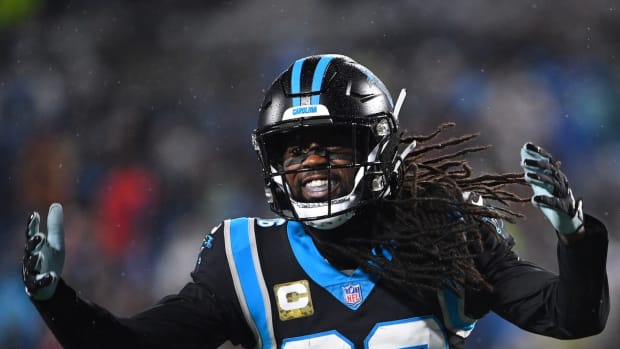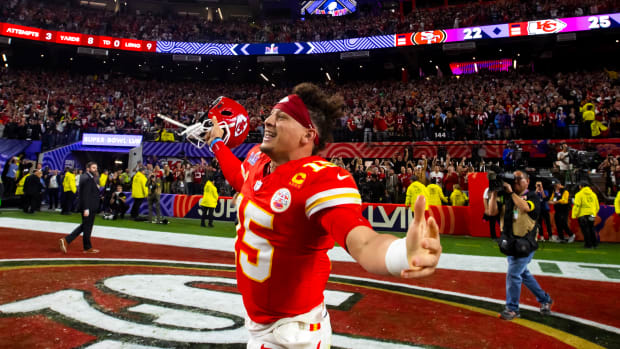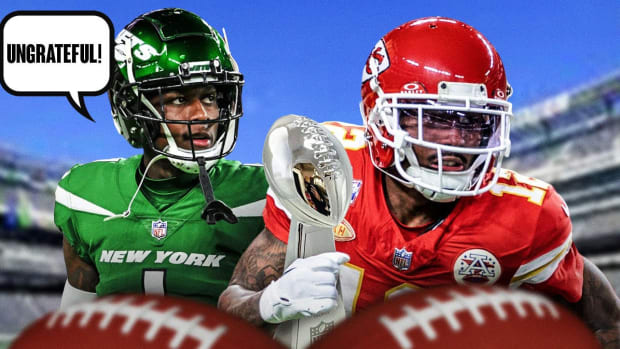A Patriots Super Bowl Run in Four Acts: II, Why the Pats of September Are Not the Pats of January
Over the Patriots’ nearly two decades under Bill Belichick, every year seems to follow a recognized pattern—from the concerns of the offseason through a firm sense of identity and purpose as January approaches. This week The MMQB examines New England’s 2018 season in four parts, Tuesday through Friday, from the perspective of that now-familiar narrative, and what it means for the Patriots’ ninth Super Bowl appearance of the Brady-Belichick era.
• I: Jenny Vrentas on Tom Brady’s odd offseason
• III: Tim Rohan on the Patriots’ mastery of the midseason move
• IV: Jenny Vrentas on how the Patriots evolve for the stretch run
On the Wednesday after the NFC Championship Game, when the Rams’ defensive staff convened for their Super Bowl game plan meeting, they made their presentation to coordinator Wade Phillips in pieces, like they do every week.
Linebackers coach Joe Barry does play-action passes, screens and bootlegs. Safeties coach Ejiro Evero does first- and second-down dropback passes. Bill Johnson, the defensive line coach, does the run game, and assistant linebackers coach Chris Shula does short-yardage and goal-line situations.
Then they start envisioning each situation as it pertains to the opponent’s personnel and habits. What might work more effectively, and what won’t.
So much of Super Bowl preparation is maintaining the routine despite the chaos orbiting just outside their hotel rooms and practice facilities. On the Thursday after the title game, Rams staffers took the agreed-upon information and brought it to the players in installments. First and second down on Thursday. On Friday, third down. Saturday, goal line. By the time they arrived in Atlanta on Sunday, they were set for a typical week of reinforcing the plan over three days of practice.
Even the youngest members of the Rams coaching staff, those who have never experienced the Super Bowl before, thought they’d managed to make it feel routine.
“You don’t want to get too much in your head, so you try and keep it pretty similar,” Shula said.
SUPER BOWL LIII: For the Rams to have a chance, they have to slow the Patriots’ run game, and that deadly inside pass
It helps deflect from the reality that there is no more difficult opponent to game plan for. Amid these familiar machinations, the Rams have to reconcile their planning for what the Patriots might do with the fact that in most seasons New England looks completely different in September than in November and December. There is a concerted effort among coaches to keep the number of relevant games they target for scouting to a standard, but also a temptation in their free time to dive into the weeds and start plucking different looks from earlier in the year.
Against New England, that’s a temptation to avoid.
From the outside looking in it appears Bill Belichick and the Patriots are simply just unafraid to experiment deep into the season, which allows each year to take on significantly different chapters. But the real reason, as their own coaches, opposing coaches and players explain, is that they have mastered the balance between their own personal micro and macroeconomics. They hone in on what it takes to win each individual game, but are concurrently self-aware of what they put on film over the course of 16 games.
“I think that’s why they’re always playing in this game,” Evero said.
The easiest example, the most evident storyline that has followed New England through the winter months, is how the Patriots morphed into a traditional two-back running team over course of the year. They utilized fullback James Develin on 30.5 snaps per game after the bye, as opposed to 21.4 before it. He’s had almost as many snaps over the last six weeks as he did over the first 10. Rookie Sony Michel has emerged as a traditional, pace-setting between-the-tackles runner who has forced opponents to defend the Patriots in a way that refreshed Tom Brady’s relationship with his typically blanketed wide receivers.
SUPER BOWL LIII: To throw or not to throw? The weight of the challenge flag on Super Bowl Sunday
In September, during a noticeably uninspiring 2-2 stretch that featured losses to the Jaguars and Lions in consecutive weeks, Michel crept above 25 snaps just once, as the Patriots seemed hell-bent on utilizing some of their most traditional passing concepts with a roster that contained just four largely unfamiliar wide receivers on opening day (Julian Edelman was on suspension). A 31-20 loss to Jacksonville bled into one of the most hapless performances of the recent Belichick-Brady era, a 26-10 defeat in Detroit that exposed the ineffectiveness of their passing game. A wide receiver did not lead the team in targets until Week 3, and that was Phillip Dorsett. Brady was largely dependent on short option passes, swings or checkdowns to his running backs.
It was the third time in the past five years that New England started 2-2, throwing those that follow the team religiously into the familiar, uncomfortable twist where they vacillate between panic over the inevitable march of time and hope that this was all part of the Patriots’ journey, that they would ultimately emerge from the slump with something more effective, as they’d done in so many previous years.
Those hopes, obviously, were rewarded. The resulting philosophical shift had tentacles. Roles were, at least in a small way, altered. Matchups changed. One example: James White, who was targeted on passing plays 8.9 times a game before the bye, saw that number nearly halved over the final weeks of the season, along with slashes in situational red zone usage. And there’s the boost in the usage of Develin, the fullback.
SUPER BOWL LIII: Josh Gordon is out of sight, out of mind, per the Patriot Way
“We never thought we would do that,” Patriots offensive line coach Dante Scarnecchia said. “And we’ve actually gravitated towards that more than any other time in the past. We’re what’s called a regular team. Fullback, halfback and wide receivers, and we just morph into other things from there. But that really is our base.”
His explanation for the shifts was at once nebulous and completely honed in on the truth about the Patriots’ offensive flexibility “It’s inherent to the system, which has been in place for 20 years.”
Sunday’s game will be one of contrasts. On common downs, the Rams essentially operate out of a small handful of personnel groupings. In 461 first-and-10 situations this year, they were in a formation with one tight end and three wide receivers 413 times. The Patriots, over the course of a season, tend to add more layers to the painting. Consider Sean McVay more of an impressionist, and Belichick an abstractionist.
Out of 437 first-and-10 snaps, the Patriots have deployed nine different groupings, four of which were used 20 or more times and two which were used with almost equal frequency, causing the opponent to guess which one they’ll use.
SUPER BOWL LIII: Action hero? Comedy star? Reality host? Assessing Rob Gronkowski’s post-football Hollywood potential
“There’s certainly a balance between having a lot of scheme and having a set number of plays you’re going to run, and I think what [offensive coordinator Josh McDaniels] has done so well here is balance those,” New England receivers coach Chad O’Shea said. “He’s able to look at a week separate than any other week. Each week is just different in his mind, and our plan of attack is obviously very different.”
Like the Rams, who piece together their defensive strategy, the Patriots put the onus on individual coaches to periodically self scout different areas to ensure that each individual game plan is not bundling into a larger, predictable narrative. Scarnecchia said that they often evaluate the offensive line, monitoring small maneuvers like hand placement or a lead foot on a run block for patterns.
It’s these small changes that snowball into larger ones. All of a sudden you’re in barreling into January as one of the few teams in the NFL plowing through defenses with a fullback as a lead blocker.
“Everybody’s got tendencies,” Rams defensive tackle Aaron Donald said this week, optimistically. “Everyone is going to show what they do at times. It’s a part of studying. I’m trying to find as much as I can on them so I can have success.”
SUPER BOWL LIII: In his last game with the Patriots, Brian Flores has his ailing mother on his mind
The search this week just might be more difficult. Reading the Patriots season is like piecing together fractured tablets from another era. There are no neat, linear chapters.
Or, as Tom Brady put it, in the type of streamlined platitude that has come to explain a process that has befuddled the NFL for nearly two decades: “It’s not always what happens in September.”
Question or comment? Email us at talkback@themmqb.com.




































